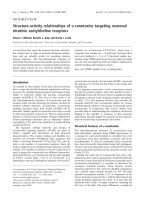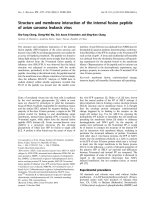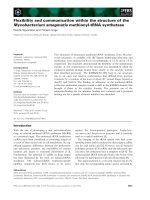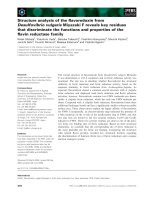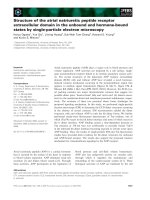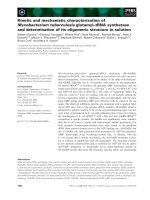Báo cáo khoa học: "Structure and yield of all-sized and even-sized Scots pine-dominated stands" ppsx
Bạn đang xem bản rút gọn của tài liệu. Xem và tải ngay bản đầy đủ của tài liệu tại đây (651.36 KB, 10 trang )
Original
article
Structure
and
yield
of
all-sized
and
even-sized
Scots
pine-dominated
stands
E
Lähde,
O
Laiho,
Y
Norokorpi,
T
Saksa
The
Finnish
Forest
Research
Institute,
Box
18,
FIN-01301
Vantaa,
Finland
(Received
4
June
1993;
accepted
22
September
1993)
Summary —
This
study
is
based
on
material
collected
in
southwestern
Finland
using
a
systematic
temporary
circular
plot
line
survey
method.
A
total
of
273
sample
plots
were
included
in
the
study.
These
plots
represented
Scots
pine
(Pinus
sylvestris
L)-dominated
stands
established
on
dryish
mineral
soil
sites.
In
half
of
the
sample
plots
the
stand
structure
was
all-sized
(ie
stem
distribution
resembled
an
inverted
letter
J).
Even-sized
stand
structure
(stem
distribution
resembled
a
normal
distribution)
applied
in
the
case
of
31%
of
sample
plots
while
17%
were
irregularly
uneven-sized
in
structure.
The
number
of
trees
per
hectare
in
the
all-sized
stands
was
more
than
twice
that
of
even-
sized
stands.
The
mean
annual
increment
increased
along
with
an
increase
in
growing
stock
volume.
The
volume
in
even-sized
stands
was
higher
than
in
all-sized
stands
but
their
mean
annual
increment
was
equal.
Nevertheless,
in
stands
with
equal
average
volume
(125
±
25
m3
/ha),
the
mean
annual
increment
in
all-sized
stands
was
one
third
higher
than
in
even-sized
stands.
stand
structure
/
yield
/
stem
distribution
/
all-sized
/
even-sized
Résumé —
Structure
et
rendement
de
peuplements
irréguliers
et
réguliers
à
majorité
de
pin
sylvestre.
Cette
étude
est
basée
sur
du
matériel
récolté
dans
le
sud-ouest
de
la
Finlande
(1951-
1953)
au
moyen
d’une
méthode
statistique
à
base
de
placettes
d’échantillonnage
circulaires
temporaires
systématiques
alignées.
L’étude
comprenait
un
total
de
273
placettes
d’échantillonnage.
Ces
placettes
représentaient
des
peuplements
de
pin
sylvestre
(Pinus
sylvestris
L)
établis
sur
des
terrains
à
sol
minéral
sec.
Dans
la
moitié
des
placettes
d’échantillonnage,
la
structure
du
peuplement
était
irrégulière
(c’est-à-dire
avec
une
distribution
des
tiges
ressemblant
à
la
lettre
J
inversée).
Des
placettes
d’échantillonnage
(31%)
représentaient
des
peuplements
réguliers
(distribution
des
tiges
ressemblant
à
une
distribution
normale)
tandis
que
17%
représentaient
une
autre
structure.
Le
nombre
de
tiges
par
hectare
dans
les
peuplements
irréguliers
était
plus
du
double
de
celui
des
peuplements
réguliers
(fig
1).
L’accroissement
annuel
moyen
a
augmenté
parallèlement
à
l’augmentation
du
volume
du
matériel
sur pied
croissant
(fig
2).
En
raison
du
fait
que
le
volume
de
peuplements
réguliers
était plus
grand
que
celui
de
peuplements
irréguliers,
leur
accroissement
annuel
moyen
était
égal
(tableau
I).
Néanmoins,
l’accroissement
annuel
moyen
de
peuplements
irréguliers
au
volume
moyen
égal
(125
± 25
m3
/ha)
était
d’un
tiers
plus
élevé
que
celui
des
peuplements
réguliers
(tableau
II).
structure
de
peuplement/rendement/distribution
des
tiges/irréguliers/réguliers
INTRODUCTION
Forests
in
the
boreal
coniferous
zone
often
develop
into
mixed
forests
of
varying
struc-
ture
(Whitmore,
1978;
Runkle,
1985;
Solo-
mon
et al,
1986;
Pobedinski,
1988;
Pren-
tice
and
Leemans,
1990;
Lähde
et al,
1991).
Nevertheless,
forest
treatment
(in
the
Nordic
countries,
for
instance)
has
led
to
modifi-
cations
of
the
natural
diameter
distribution.
The
practice
in
the
first
half of
this
century
was
to
level
out
stand
structure
by
re-
moving
bigger
trees
in
conjunction
with
dimension
fellings
and
thinnings
from
above.
Gradually,
cuttings
were
changed
towards
thinning
from
below,
ie
of
removing
smaller
trees
and
thereby
levelling
out
stand
struc-
ture.
Thinning
from
below
became
the
gene-
rally
approved
practice
of
stand
tending
in
the
Nordic
countries
in
the
second
half
of
this
century.
Nevertheless,
the
all-sized
(all-
aged)
structure
of
the
forests
still
persists
(Arman,
1965;
Skogsstatistik
årsbok,
1989;
Lähde
et al,
1992).
The
data
presented
on
naturally
esta-
blished
stands
in
Finland,
for
example,
ori-
ginate
from
selected
stands
where
the
understorey
has
been
neglected
or
the
ini-
tially
all-sized
growing
stock
has
been
trans-
formed
by
cleaning
and/or
thinning
from
below
to
resemble
an
even-sized stand
(Ilvessalo,
1920a,
1920b;
Lönnroth,
1925;
Lappi-Seppälä,
1930;
Koivisto,
1954;
Nyyssönen,
1954;
Vuokila,
1956).
In
gene-
ral,
results
on
the
yields
of
all-sized
and
even-sized
stands
based
on
comparative
trials
are
still
not
available.
National
forest
inventories,
however,
give
possibilities
for
yield
comparison.
This
material
is
charac-
terized
by
being
representative
and
it
depicts
the
actual
situation
in
the
forest.
This
study
consists
of
national
forest
inventory
data
used
to
compare
the
occur-
rence,
structure
and
yield
of
all-sized
and
even-sized
Scots
pine-dominated
stands
with
and
without
admixtures
of
broad
leaved
trees
on
dryish
mineral
soil
sites
in
south-
western
Finland.
The
hypotheses
applied
in
the
study
are
as
follows:
(1)
an
admix-
ture
of
broad
leaved
species
has
a
beneficial
influence
on
the
stand
growth;
and
(2)
dif-
ferences
in
stem
distribution
have
no
influence
on
the
stand
growth.
MATERIALS
AND
METHODS
The
study
is
based
on
the
material
provided
by
the 3rd
national
forest
inventory
conducted
in
Fin-
land
during
the
years
1951-1953.
The
data
were
collected
by
a
systematic
temporary
circular
plot
inventory
on
dryish
mineral
soil
sites
(Vaccinium
type;
see
Cajander,
1949)
in
southwestem
Finland
(60° -
62°N,
21°-27°E).
The
mean
dominant
height
(100
thickest
trees/ha)
was
also
mea-
sured
on
most
of
the
plots.
This
was
used
as
a
measure
of
site
quality.
Sample
plots
classified
as
being
in
the
thinning,
preparatory,
or
regenera-
tion
stages
were
selected
for
closer
examination.
The
silvicultural
state
had
to
be
good
or
satisfac-
tory
or
the
stands
had
to
have
been
untreated
for
years
(ilvessalo,
1951).
A
further
requirement
was
that
the
growing
stock
had
to
amount
to
40
m3
/ha
or
more.
Each
sample
plot
represented
a
particular
stand.
If
a
systematically
placed
sample
plot
fell
on
the
boundary
between
2
stands
it
was
moved
to
within
a
uniform
stand
(Ilvessalo,
1951).
Thus,
the
structure
on
any
plot
could
not
be
an
admix-
ture
of
different
stands.
Plot
size
was
0.1
ha
(1
000
m2)
for
trees
exeeding
10
cm.
A
smaller
concentric
circle
(0.01
ha
or
100
m2)
was
delimi-
ted
for
tallying
trees
with
dbh
(diameter
at
breast
height)
of
2-10
cm.
Small
broad
leaved
trees
of
vegetative
origin
were
not
measured.
In
this
study,
the
trees
were
classified
into
9
dbh
classes
as
follows:
1
=
2-6;
2
=
6-10;
3
=
10-14;
4 = 14-18; 5 = 18-22;
6
= 22-26;
7
=
26-30;
8
= 30-34;
and
9
=
>
34
cm.
Scots
pine
(Pinus
sylvestris
L)
and
Norway
spruce
(Picea
abies
L
Karst)
were
kept
separate.
Broad
leaved
trees
were
combined
to
form
the
third
group.
Most
of
the
broad
leaved
trees
were
birches
(mainly
Betula
pubescens
Ehrh
and
B pendula
Roth).
The
stands
were
classified
according
to
their
stem
distribution.
Four
stands
were
rejected
for
the
following
reasons:
3
were
2-storeyed
and
1
sample
plot
had
small
trees
only.
Thus,
the
mate-
rial
included
a
total
of
273
stands.
They
were
indi-
vidually
classified
(table
I)
into
3
main
groups
as
follows
(applying
the
classifications
used
by
Smith
(1962)
and
Daniel
et al (1979)):
J:
All-sized.
Stem
distribution
resembling
an
inverted
letter
J;
trees
present
in
at
least
the
4
smallest
diameter
classes,
with
the
mode
in
the
first
or
second
class;
E:
Even-sized.
Stem
distribution
resembling
a
normal
distribution;
mode
in
neither
of
the
2
smallest
diameter
classes
nor
at
either
end
of
the
distribution.
O:
Others
(irregularly
uneven-sized).
This
group
contained
all
other
structurally
uneven-
sized
sample
plots
(only
some
main
results
are
given).
Classifications
of
another
kind
have
also
been
used
in
describing
the
stand
structure.
Leemans
(1991)
and
Szwagrzyk
(1992),
for
instance,
used
the
age,
height,
dbh,
and
exact
tree
location
as
a
character.
In
addition,
the
sample
plots
were
divided
into
2
tree
species
groups
according
to
stem
number:
A:
Conifer
stands.
No
more
than
120
broad-
leaved
trees
per
ha
(average
=
30).
B:
Mixed
(broadleaved-coniferous)
stands.
More
than
120
broad
leaved
trees
per
ha
(ave-
rage
=
422;
basal
area
16%).
Comparison
of
the
yield
between
different
stand
groups
is
presented
as a
mean
annual
increment
(excluding
bark)
for
the
total
material
and
for
the
same
average
volume
class,
and
as
a
relative
growth
(%).
The
effect
of
stand
structure
and
tree
species
composition
on
different
stand
parameters
was
analysed
with
2-way
analyses
of
variance.
The
differences
between
different
group
means
were
tested
with
Tukey’s
test.
The
dependence
between
mean
annual
increment
and
volume
in
stands
with
different
structure
and
tree
species
composition
was
analysed
with
regression
analysis.
RESULTS
Structure,
tree species
composition
and
stem
number
About
a
half
(52%)
of
the
stands
had
all-
sized
structure,
31 %
were
even-sized,
and
17%
were
other
(irregularly
uneven-sized)
(table
I).
The
average
amount
of
broad
lea-
ved
trees
(stems/ha)
varied
considerably
within
the
structure
groups.
The
average
proportion
of
broad
leaved
species
was
19%
in
all-sized
mixed
stands.
The
correspon-
ding
figure
in
the
other
groups
was
over
30%.
The
number
of
stems
per
ha
in
mixed
stands
exceeded
that
of
conifer
stands
by
the
amount
of
broad
leaved
trees
(fig
1).
This
difference
was
concentrated
in
small
trees
(dbh
<
10
cm).
The
number
of
stems
per
ha
in
all-sized
stands
was
more
than
double
that
of
the
other
groups.
In
even-
sized
stands,
the
average
number
of
stems
per
ha
was
close
to
1
000;
of
these,
small
trees
(dbh
<
10
cm)
accounted
for
slightly
more
than
200.
Scots
pine
was
the
dominant
species
in
all
structures
and
tree
species
groups
(fig
1).
Its
average
proportion
varied
within
the
range
of
45-70%.
On
being
examined
per
tree
species
(Scots
pine,
Norway
spruce
and
broad
leaved
species),
the
stem
distri-
butions
in
all-sized
stands,
on
average,
also
resembled
an
inverted
letter
J.
In
even-sized
and
irregularly
uneven-sized
(others)
stands,
the
stem
distribution
for
Scots
pine
resem-
bled
a
normal
distribution.
In
the
case
of
Norway
spruce,
this
applied
only
to
the
even-sized
mixed
stand.
Yield
The
largest
differences
of
volume
between
all-sized
stands
and
even-sized
conifer
stands
were
statistically
significant
(p
< 0.01)
(table
I).
The
latter
volume
was
about
30
m3
greater
than
the
volume
of
all-sized
stands.
The
relative
growth
(%,
average
of
the
5
previous
years)
in
mixed
stands
was
about
10%
greater
than
in
conifer
stands.
The
dif-
ferences
were
not,
however,
statistically
significant.
The
average
relative
growth
in
all-sized
stands
was
considerably
greater
than
in
even-sized
stands
(table
I).
In
the
all-sized
conifer
stands
it
was,
on an
ave-
rage,
38%
higher
than
in
corresponding
even-sized
stands
(p
< 0.01).
In
mixed
stands
the
difference
was
even
greater,
43%
(p<0.01).
The
dominant
height
(xse,
m)
in
all-sized
and
even-sized
stands
is
presented
in
the
following
setting:
All-sized
Conifer
16.2
± 0.4
Mixed
16.1
±
0.3
Even-sized
Conifer
18.1 ± 0.3
Mixed
17.2 ± 0.4
The
dominant
height
in
all-sized
stands
differed
significantly
(p
<
0.01)
from
that
in
even-sized
conifer
stands.
Due
to
the
volume
differences
between
the
all-sized
and
even-sized
stands,
the
dif-
ferences
in
mean
annual
increment
(m
3
/ha)
levelled
out
(table
I).
The
mean
annual
incre-
ment
increased
linearly
with
increasing
volume
(fig
2).
The
difference
in
growth
(33%)
within
the
same
average
volume
class
(125 ±
25
m3
/ha)
in
the
aforementio-
ned
stands
was
statistically
significant
(p
<
0.001),
see
table
II.
The
mean
dominant
height
was
16.5
m
in
all-sized
stands
and
17.6
m
in
even-sized
stands.
The
difference
was
significant
(p
< 0.05).
The
mean
annual
increment
(including
bark:
average
bark
per-
centage
16,
Ilvessalo,
1956)
in
this
volume
class
of
all-sized
stands
was
5.2
m3
/ha
or
a
third
higher
than
in
even-sized
stands.
DISCUSSION
The
generally
accepted
view
in
the
Nordic
countries
is
that
Norway
spruce
is
the
most
shade-tolerant
of
the
main
tree
species;
next
come
the
birches;
and
Scots
pine
is
the
least
shade-tolerant
of
all.
This
has
lead
to
the
conclusion
that
only
stands
dominated
by
Norway
spruce
are
capable
of
developing
all-sized
(all-aged)
structure
(Sarvas,
1948;
Mikola,
1984).
Norway
spruce
possesses
an
excellent
capacity
for
recuperation
when
released
from
the
oppression
of
the
over-
storey
(Pöntynen,
1929;
Cajander,
1934).
Birches
are
also
capable
of
emerging
as an
understorey,
even
under
Norway
spruce
(Lähde
et
al,
1991,
1992;
Lähde,
1992a,
1992b;
Laiho,
1992).
As
an
understorey,
Scots
pine
thrives
best
under
older
pines,
but
can
also
survive
under
birch
(Laiho,
1992).
Scots
pine
has
also
been
observed
to
be
able
to
recover
fairly
well
when
released
(Vaartaja,
1951).
The
survival
of
Scots
pine
as
an
under-
storey
is
also
good
on
virgin
and
drained
peatlands
(Heikurainen,
1971;
Hånell,
1984;
Gustavsen
and
Päivänen,
1986;
Hökkä
and
Laine,
1988;
Hökkä
et al,
1991).
As
on
peat-
lands,
pine-dominated
stands
on
dry
mine-
ral
soils
(especially
in
the
northern
regions)
are
usually
uneven-aged
and
all-sized
(Lakari,
1915;
Aaltonen,
1919;
Lassila,
1920;
Huse,
1965;
Ilvessalo,
1970;
Sjörs
and
Zac-
krisson,
1984;
Norokorpi,
1992).
According
to
this
study,
the
pine-domina-
ted
forests
in
southwestern
Finland
on
dryish
mineral
soils
were
mainly
all-sized
in
struc-
ture,
ie
their
stem
distribution
resembled
an
inverted
letter
J.
These
soils
are
sufficiently
fertile
for
Norway
spruce
and
birches
to
be
raised
alongside
Scots
pine.
Norway
spruce
and
broad
leaved
species
accounted
for
nearly
a
half
of
the
stem
number.
Observations
made
in
North
America
indicate
that
Loblolly
pine
(Pinus
taeda
L)
(Reynolds,
1969)
and
Ponderosa
pine
(Pinus
ponderosa
Dougl
ex
Laws)
(Roe,
1952;
Alexander
and
Edminster,
1978)
can
be
raised
as
all-sized
stands.
According
to
Foiles
(1978),
such
stands
must
be
logged
heavily
enough
to
provide
these
light-
demanding
species
with
sufficient
light.
On
examining
selected
research
mate-
rial,
Mielikäinen
(1980)
observed
that
Sil-
ver
birch
(Betula
pendula)
has
a
beneficial
influence
on
the
growth
of
stands
domina-
ted
by
Scots
pine
in
southern
Finland.
According
to
Mielikäinen,
just
a
small
amount
of
birch
(less
than
20%
of
the
volume)
enhanced
the
growth
of
Scots
pine.
The
influence
of
Downy
birch
(B
pubescens)
was
not
as
strong.
Lappi-Seppälä
(1930)
and
Jonsson
(1962)
also
observed
that
Scots
pine
grows
better
in
virgin
stands
with
an
admixture
of
birch
than
in
pure
stands.
This
study
did
not
reveal
any
statistically
significant
differences
in
growth
between
mixed
(broad
leaved-coniferous)
stands
and
conifer
stands
although
the
general
trend
was
similar
to
that
reported
in
the
afore-
mentioned
studies.
Thus,
the
first
hypothe-
sis
(that
broad
leave
species
would
enhance
volume
growth)
was
not
confirmed.
It
has
previously
been
observed
in
the
same
region
that
spruce-dominated
mixed
stands
grew
better
than
conifer
stands
(Lähde
et
al,
1994).
The
material
in
the
latter
study
was
clearly
larger
than
in
this
study.
The
results
of this
study
showed
that
rela-
tive
growth
in
all-sized
stands
was
about
40%
higher
than
in
even-sized
stands.
This
finding
was
enhanced
by
the
difference
in
dominant
height.
Lähde
et al (1994)
have
also
observed
a
similar
difference
in
growth
of
spruce-dominated
stands.
When
stands
with
the
same
volume
were
examined
in
the
present
study,
the
increment
in
all-sized
stands
was
significantly
(33%)
higher
than
in
even-sized
stands.
Thus,
the
second
hypo-
thesis
of
the
study
(differences
in
stem
dis-
tribution
have
no
influence
on
growth)
was
also
left
unconfirmed.
On
the
contrary,
all-
sized
stands
grew
clearly
better
than
even-
sized
stands.
The
results
of this
study
indicate
that
all-
sizedness
of
the
growing
stock
enhances
stand
yield
in
pine-dominated
stands
on
dryish
mineral
soil
sites.
Lähde
et al (1994)
have
observed
the
same
in
connection
with
spruce-dominated
stands
established
on
fertile
mineral
soil
sites.
This
result
means
that
structural
all-sizedness
should
be
taken
into
account
as
an
alternative
in
the
silvi-
culture
of
pine-dominated
stands.
ACKNOWLEDGMENTS
We
thank
M
Hagner,
JP
Schütz,
K
Andreassen,
LH
Frivold,
and
2
anonymous
reviewers
for
manuscript
review.
REFERENCES
Aaltonen
VT
(1919)
Kangasmetsien
luonnolli-
sesta
uudistumisesta
Suomen
Lapissa.
1.
Referat:
Über
die
natürliche
Verjüngung
der
Heidewälder in
Finnischen
Lappland.
1.
Com-
mun
Inst
For
Fenn
1, 1-319
Alexander
RR,
Edminster
CB
(1978)
Regulation
and
control
under
uneven-aged
management.
In:
Uneven-aged
silviculture
and management
in
the
United States.
US
Dep
Agric,
For
Serv.
Timber
management
research.
Washington,
DC
Gen
Tech
Rep
WO-24, 217-230
Arman
V
(1965)
Riksskogstaxeringen
åren
1953-
1962.
Summary:
The
National
Forest
Survey
carried
out
in
1953-1962.
Department
of
Forest
Survey.
Royal
college
of
forestry.
Research
Notes 9,
1-73
Cajander
AK
(1949)
Forest
types
and
their
signi-
ficance.
Acta
For Fenn 56, 1-71
Cajander
EK
(1934)
Kuusen
taimistojen
vapaut-
tamisen
jäkeisestä
pituuskasvusta.
Commun
Inst
For
Fenn
19,
1-53
Daniel
TW,
Helms
JA,
Baker
FS
(1979)
Principles
of
silviculture.
McGraw-Hill
Book
Company,
2nd
ed,
500
p
Foiles
MW
(1978)
Stand
structure.
In:
Uneven-
aged
silviculture
and
management
in
the
United
States.
US
Dep
Agric,
For
Serv,
Tim-
ber
management
research.
Washington,
DC
Gen
Tech
Rep
WO-24, 176-185
Gustavsen
HG,
Päivänen
J
(1986)
Luonnonti-
laisten
soiden
puustot
kasvullisella
metsä-
maaua
1950-luvun
alussa.
Summary:
Tree
stands
on
virgin
forested
mires
in
the
early
1950s
in
Finland.
Folia
For 673,
27
p
Hånell
B
(1984)
Skogsdikningsboniteten
hos
Sve-
riges
torvmarker.
Sveriges
lantbruksuniversi-
tet.
Rapporter
i
skogsekologi
och
skoglig
marklära 50,
125 pp
Heikurainen
L
(1971)
Virgin
peatland
forests
in
Finland.
Acta
Agralia
Fennica
123, 11-26
Hökkä
H,
Laine
J
(1988)
Suopuustojen
raken-
teen
kehitys
ojituksen
jälkeen.
Summary:
Post-
drainage
development
of
structural
charac-
ters
in
peatland
forest
stands.
Silva
Fennica
22, 45-65
Hökkä
H,
Piiroinen
ML,
Penttilä
T
(1991)
Läpi-
mittajakauman
ennustaminen
Weibull-jakau-
malla
Pohjois-Suomen
mänty-
ja
koivuvaltai-
sissa
ojitusaluemetsiköissä.
Summary:
The
estimation
of
basal
area-dbh
distribution
using
the
Weibull-function
for
drained
pine-
and
birch-
dominated
and
mixed
peatland
stands
in
north
Finland.
Folia
For 781,
22
pp
Huse
S
(1965)
Strukturformer
hos
urskogbestånd
i
Övre
Pasvik.
Referat:
Strukturformen
von
Urwaldbeständen
in
Övre
Pasvik.
Meldinger
fra
Norges
landbrukshøgskole
44,
1-81
Ilvessalo
Y
(1920a)
Tutkimuksia
metsätyyppien
taksatoorisesta
merkityksestä
nojautuen
etupäässä
kotimaiseen
kasvutaulujen
laati-
mistyöhön.
Referat:
Untersuchungen
über
die
taxatorische
Bedeutung
der
Waldtypen,
hauptsächlich
auf
den
Arbeiten
für
die
Auf-
stellung
der
neuen
Ertragstafeln
Finnlands
fussend.
Acta
For
Fenn
15,
1-15
Ilvessalo
Y
(1920b)
Kasvu- ja
tuottotaulukot
Suo-
men
eteläpuoliskon
mänty-,
kuusi-
ja
koivu-
metsille.
Referat:
Ertragstafeln
für
die
Kiefern,
Fichten-
und
Birkenbestände
in
der
Südhälfte
von
Finnland.
Acta For Fenn
15,
1-94
Ilvessalo
Y
(1951)
III
valtakunnan
metsien
arviointi.
Suunnitelma
ja
maastotyön
ohjeet.
Summary:
Third
national
forest
survey
of
Fin-
land.
Plan
and
instructions
for
field
work.
Com-
mun
Inst
For
Fenn
39(3),
1-67
Ilvessalo
Y
(1956)
Suomen
metsät vuosista
1921-
24
vuosiin
1951-53.
Kolmeen
valtakunnan
metsien
inventointiin
perustuva
tutkimus.
Sum-
mary:
The
forests
of
Finland
from
1921-24
to
1951-53.
A
survey
based
on
three
national
forest
inventories.
Commun
Inst
For
Fenn
47,
1-227
Ilvessalo
Y
(1970)
Metsiköiden
luontainen
kehi-
tys-
ja
puuntuottokyky
Pohjois-Lapin
kivennäismailla.
Summary:
Natural
develop-
ment
and
yield
capacity
of
forest
stands
on
mineral
soils
in
northern
Lapland.
Acta
For
Fenn 108, 1-43
Jonsson
B
(1962)
Om
barrblandskogens
volym-
produktion.
Summary:
Yield
of
mixed
conifer-
ous
forest.
Medd
Statens
Skogsforskningsinst
50, 1-143
Koivisto
P
(1954)
Kasvu-ja
tuotostaulukoita.
Sum-
mary:
Growth
and
yield
tables.
Commun
Inst
For
Fenn
5, 1-49
Lähde
E
(1992a)
Natural
regeneration
of
all-sized
spruce-dominated
stands
treated
by
single
tree
selection.
In:
Silvicultural
alternatives.
Proc
Int
Workshop
June
22-25
1992
(M
Hagner,
ed).
Swedish
University
of
Agricultu-
ral
Sciences,
Department
of
Silviculture,
Reports,
No
35, 117-123
Lähde
E
(1992b)
Regeneration
potential
of
all-
sized
spruce-dominated
stands.
In:
Silvicul-
tural
alternatives.
Proc
Internordic
Workshop
June
22-25
1992
(M
Hagner,
ed).
Swedish
University
of
Agricultural
Sciences.
Depart-
ment
of
Silviculture,
Reports,
No
35,
111-
116
Lähde
E,
Laiho
O,
Norokorpi
Y,
Saksa
T
(1991)
The
structure
of
advanced
virgin
forests
in
Finland.
Scand J For Res 6, 527-537
Lähde
E,
Laiho
O,
Norokorpi
Y,
Saksa
T
(1992)
Stand
structure
of
thinning
and
mature
conifer-
dominated
forests
in
boreal
zone.
In:
Silvicul-
tural
alternatives.
Proc
Int
Workshop
June
22-
25
1992
(M
Hagner,
ed).
Swedish
University
of
Agricultural
Sciences.
Department
of
Silvi-
culture,
Reports,
No
35,
58-65
Lähde
E,
Laiho
O,
Norokorpi
Y,
Saksa
T
(1994)
Structure
and
yield
of
all-sized
and
even-sized
conifer-dominated
stands
on
fertile
sites.
Ann
Sci For 51, 2 (in
press)
Laiho
O
(1992)
Understoreys
in
the
forests
of
Finland.
In:
Silvicultural
alternatives.
Proc
Int
Workshop
June
22-25
1992
(M
Hagner,
ed).
Swedish
University
of
Agricultural
Sciences.
Department
of
Silviculture,
Reports,
No
35,
100-103
Lakari
OJ
(1915)
Studien
über
die
Samenjahre
und
Altersklassenverhältnisse
der
Kie-
fernwäldern
auf
dem
nordfinnischen
Heide-
boden. Acta
For
Fenn
5,
1-211
Lappi-Seppälä
M
(1930)
Untersuchungen
über
die
Entwicklung
gleichaltiger
Mischbestände
aus
Kiefer
und
Birke.
Summary
in
Finnish.
Commun
Inst For Fenn
15,
1-241
Lassila
I (1920)
Tutkimuksia
mäntymetsien
syn-
nystä
ja
kehityksestä
pohjoisen
napapiirin
poh-
joispuolella.
Referat:
Entstehung
und
Ent-
wicklung
der
Kiefernwäldern
nördlichen
Polarkreise.
Acta
For Fenn
14,
1-95
Leemans
R
(1991)
Canopy
gaps
and
establish-
ment
patterns
of
spruce
(Picea
abies
(L)
Karst)
in
two
old-growth
coniferous
forests
in
cen-
tral
Sweden.
Vegetatio 93,
157-165
Lönnroth
E
(1925)
Untersuchungen
über
die
innere
Struktur
and
Entwicklung
gleichaltiger
naturnormale
Kiefernbeständer
basiert
auf
Material
aus
der
Südhälfte
Finnlands.
Acta
For Fenn 30,
1-269
Mielikäinen
K
(1980)
Mänty-koivusekametsiköiden
rakenne
ja
kehitys.
Summary:
Structure
and
development
of
mixed
pine
and
birch
stands.
Commun
Inst
For
Fenn
133,
1-79
Mikola
P
(1984)
Harsintametsätalous.
Summary:
Selection
system.
Silva
Fennica
18(3),
293-301
Norokorpi
Y
(1992)
Natural
structure
and
devel-
opment
of
forests
as
a
basis
for
alternative
silvicultural
methods
in
northern
Finland.
In:
Silvicultural
alternatives.
Proc
Int
Workshop
June
22-25
1992
(M
Hagner,
ed).
Swedish
University
of
Agricultural
Sciences.
Depart-
ment
of
Silviculture,
Reports,
No
35,
78-85
Nyyssönen
A
(1954)
Hakkauksilla
käsiteltyjen
männiköiden
rakenteesta
ja
kehityksestä.
Summary:
On
the
structure
and
development
of
Finnish
pine
stands
treated
with
different
cuttings.
Acta
For
Fenn
60(4),
1-194
Pobedinski
AV
(1988)
Comparative
evaluation
of
even-aged
and
uneven-aged
stands
(in
Russian).
Lesnoe
Khozyaistvo
2,
40-43
Pöntynen
V
(1929)
Tutkimuksia
kuusen
esiinty-
misestä
alikasvoksena
Raja-Karjalan
valtion-
mailla.
Referat:
Untersuchungen
über
das
Vor-
kommen
der
Fichte
(Picea
excelsa)
als
Unterwuchs
in
den
finnischen
Staatswäldern
von
Grenz-Karelien.
Acta
For Fenn 35, 1-235
Prentice
IC,
Leemans
R
(1990)
Pattern
and
pro-
cess
and
the
dynamics
of
forest
structure:
A
simulation
approach.
J
Ecol 78,
340-355
Reynolds
RR
(1969)
Twenty-nine
years
of
selec-
tion
timber
management
on
the
Crossett
Experimental
Forest.
US
Dep
Agric,
For
Serv
Stn Pap SO-40,
19
p
Roe
AL
(1952)
Growth
of
selectively
cut
ponde-
rosa
pine
stands
in
the
upper
Columbia
Basin.
US
Dep
Agric,
For
Serv
Agricultural
Hand-
book
39, 28
p
Runkle
JR
(1985)
Disturbance
regimes
in
tem-
perate
forests.
In:
The
ecology
of
natural
dis-
turbance
and
patch
dynamics
(STA
Pickett,
PS
White,
eds).
Academic
Press
Inc,
New
York,
17-34
Sarvas
R
(1948)
Harsinnan
ajahuskitkettävä
ammattikunnastamme.
Metsätaloudellinen
Aikakauslehti
11,
325-328
Sjörs
H,
Zackrisson
O
(1984)
Dynamik,
struktur
och
funktion
hos
de
fjällnära
skogarna.
In:
Skogsföryngring
i fjällnära
skogar (PO
Bäcks-
tröm,
ed).
Forskarrapport.
Sveriges
Lantbruk-
suniversitet,
Skogsvetenskapliga
fakulteten,
24-30
Skogsstatistisk
årsbok
(1989)
Sveriges
officiella
statistik.
Skogsstyrelsen,
Jönköping,
300
p
Solomon
DS,
Hosmer
RA,
Hayslett
HT
Jr
(1986)
A
two-stage
matrix
model
for
predicting
growth
of
forest
stands
in
the
northeast.
Can
J
For
Res
16
(3),
521-528
Szwagrzyk
J (1992)
Small-scale
spatial
patterns
of
trees
in
a
mixed
Pinus
sylvestris-Fagus
syl-
vatica
forest.
For
Ecol
Manage
51, 301-315
Vaartaja
Y
(1951)
Alikasvosasemasta
vapautet-
tujen
männyn
taimistojen
toipumisesta
ja
mer-
kityksestä
metsänhoidossa.
Summary:
On
the
recovery
of
released
pine
advance
growth
and
its
silvicultural
importance.
Acta
For
Fenn
58,
1-133
Vuokila
Y
(1956)
Etelä-Suomen
hoidettujen
kuu-
sikoiden
kehityksestä.
Summary:
On
the
development
of
managed
spruce
stands
in
southern
Finland.
Commun
Inst For Fenn 48,
1-138
Whitmore
TC
(1978)
Gaps
in
the
forest
canopy.
In:
Tropical
trees
as
living
systems
(PB
Tom-
linson,
MH
Zimmerman,
eds).
Proc
4th
Cabot
Symp
Harvard
Forest
(1976),
Cambridge,
England, 639-655



